The First Dirt Salesmen
A quixotic attempt to find the first seller of topsoil.
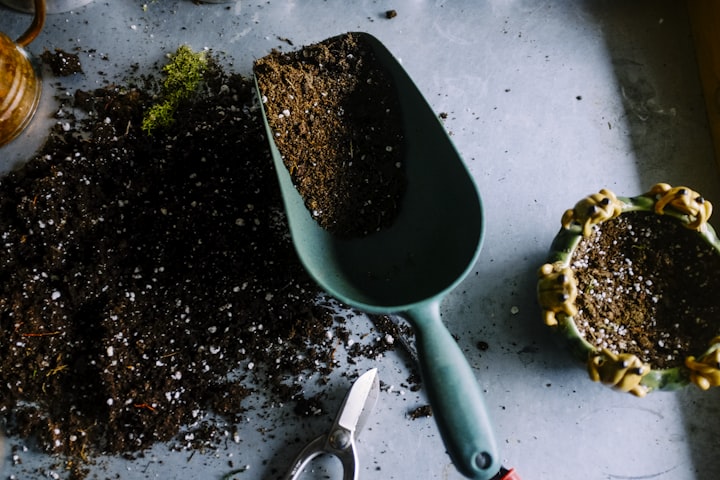
Americans regularly buy dirt, or as marketing would have us call it, potting soil. We're so used to it now, but it's an odd concept. Pay money for the most freely available think around? A question took a hold of me, and I needed to know the answer: Who first sold dirt?
A quick Google search gave me results about the first plants grown in moon dirt. Which is interesting in its own right, but not what I asked. Tweaking my search parameters and I learn that soil first developed on Earth around 3.7 billion years ago, but not when it was first sold. I reached out to Reddit and got this response:
The concept of selling soil is not something that can be traced back to a single "first" company, as soil has been bought and sold for various purposes throughout history. However, if we consider the commercial sale of packaged soil for gardening or landscaping purposes, it is difficult to determine a specific company that was the absolute first.
Useless. I guess I should clarify here that I'm not interested in say, farmers trading some dirt or earth being moved for a public works project. I learned on a recent trip to New York that when Central Park was being created in the 1850's "Even the dirt was imported; the natural topsoil was so poor that 500,000 cubic feet of topsoil was shipped in from New Jersey." However, this is incidental to my question: Who first said, "Hey, John Q. Public, the dirt at your feet isn't good enough. Buy my dirt!" Because without that guy we wouldn't have this Simpson's gag:
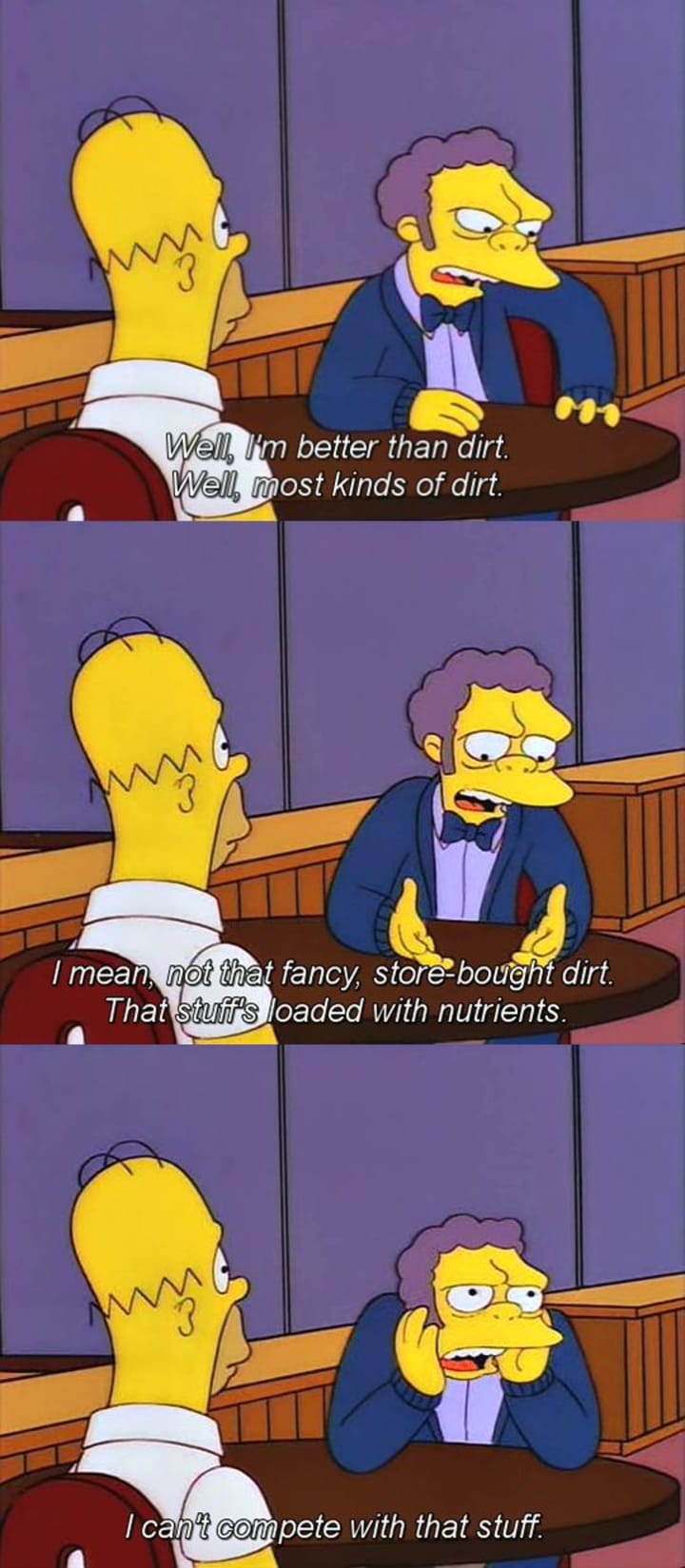
This was going to require a deeper dive. I started checking gardening companies to see if anyone was claiming to be the first to sell dirt. The industry giant, ScottsMiracle-Gro, started in 1868, says their founder, Civil War veteran Orlando McLean Scott, was the first to develop and sell seeds for consumer markets. However, there is no indication of when they first started selling dirt. Other companies are too young to have been the first (as you will soon see).
I picked up the book A History of the Garden in Fifty Tools by Bill Laws. I knew it was a bit of a stretch to call soil a tool, but I figured it was worth a try. The book turned out to include things only tangentially connected to gardening such as the Latin language and the radio, but not bagged soil. I did like the definition of soil within: a growing medium made up of organic matter, rock and mineral particles, and its performance depends on the quantities and qualities of these three ingredients.
Still, even if the book didn't mention commercial dirt, I thought that the author might know something, so I reached out to him. He responded thus:
An interesting line of horticultural research . . . but I’m afraid I’ve no answers! I guess the leads would be in old garden/homebuilding magazines or with companies that have been involved in that kind of thing for a long time.
OK, this gave me a plan of attack: investigate old magazines. And I soon got some pay off. Here is an ad from The Garden Magazine, April 1905
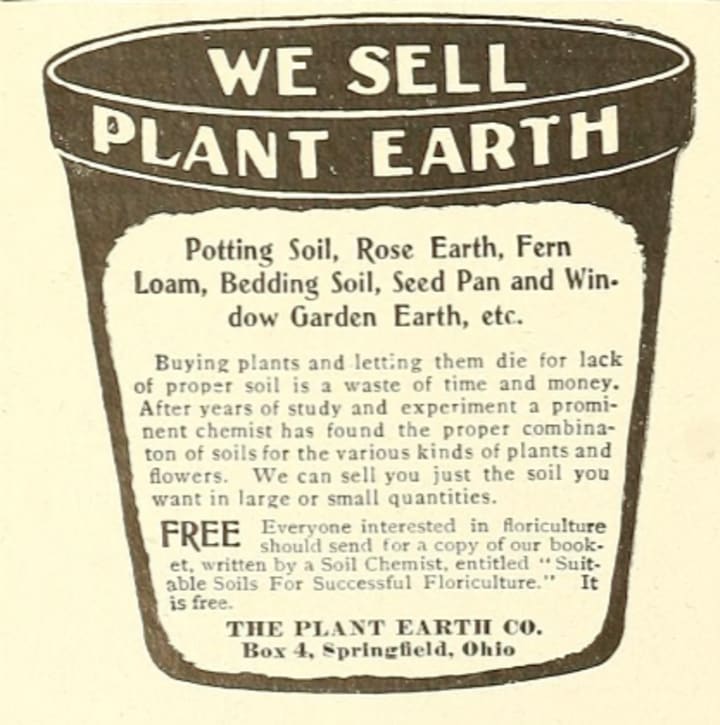
From there I have a starting point to work from, since I know soil was definitely being sold by 1905. Now to see how far back I can push it.
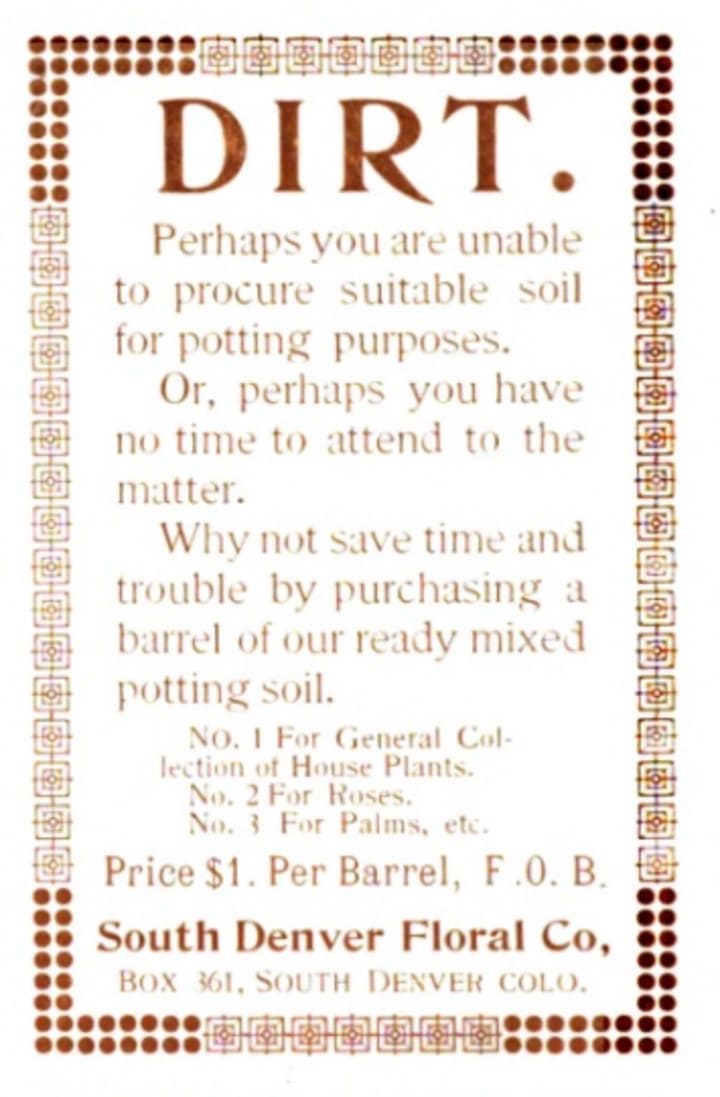
This ad for DIRT is from an 1893 issue of The Western Garden. Onward I pushed, finding an ad in The Gardener's Chronical in 1874. After that though I started to spin my wheels, doing a lot of searches without results. Along the way I found an offer of $100 for the biggest bullfrog in America. An ad for Barnum’s Great American Museum, whose headline attraction was just fat women. And there was an editorial about how it was folly, possibly a crime, to claim “that the white man at the South seeks to oppress the negro.” from 1867.
For all that, I didn't see anyone selling soil. What I did see though, was plenty of people selling seeds. For example, this ad for seeds from a January 1841 magazine, though irritatingly the ad itself says December 1840.

So when ScottsMiracle-Gro says they were the first to sell seeds... they weren't. And I don't think J. Kernan was the first either. While potting soil is something of a luxury good, seeds are a necessity: you can grow without store bought soil, but not without seeds. Hence the first seller of seeds probably pre-dates the written record.
I eventually realized I had made an error in searching all these American magazines, when the last success I'd had was with a British magazine. I went back to The Gardeners' Chronicle and would go on to find this ad from 1850:
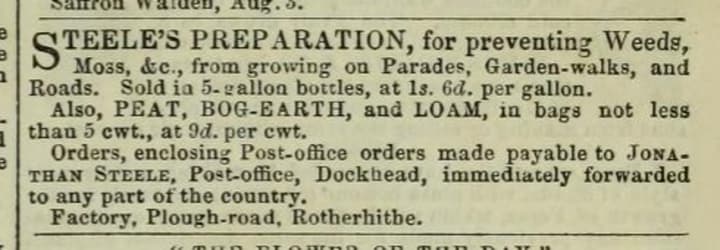
"Also, PEAT. BOG-EARTH, and LOAM, in bags not lest than 5 cwt., at 9d. per cwt." While I don't know what cwt means, I understand that Mr. Jonathan Steele of Rotherhithe is selling types of soil, and in bags just like contemporary merchants. We can push the date back a bit further though. For we have this ad from 1848:
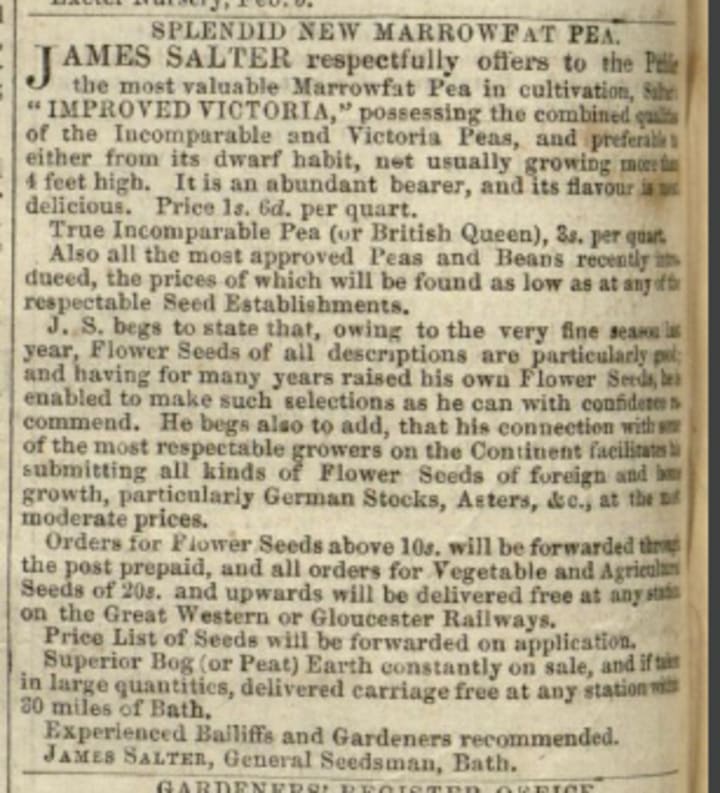
James Salter of Bath is selling "Superior Bog (or Peat) Earth." He's not selling it by the bag and he doesn't have loam, but he precedes Steele by two years. We also know that Mr. Salter was selling seeds back in 1846, but he doesn't mention any soils for sale then.
Now we need to talk about how there' not always a clear cut line between soil and fertilizer. Here is an ad from 1844 for different types of manure:
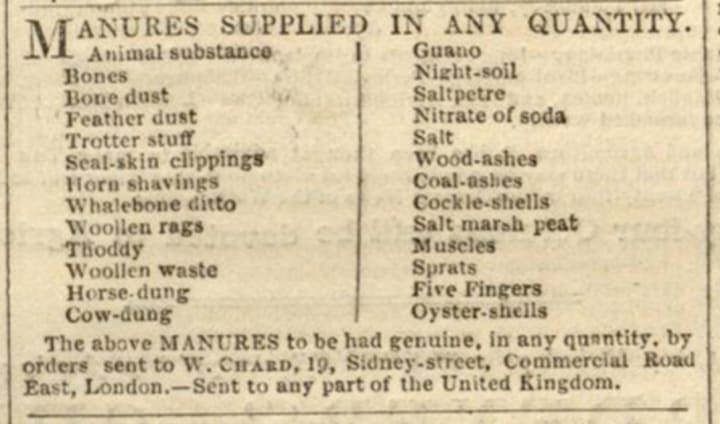
One of the items listed is "Salt marsh peat." Peat is defined as "a brown deposit resembling soil..." Modern bags of potting soil often contain a lot of peat. The ad here is for "MANURES" though, not soil. While loam is certainly a soil, it's a bit fuzzy for peat. I'm inclined to say this is a precursor to selling soil.
I could not find evidence of anyone selling soil before this, and boy did I look. It turns out my hometown has an entire library dedicated to gardening. I knew I had to go to the Peter H. Raven Library, but it's not a place you can just walk into. I had to contact them and explain to a librarian why I wanted to go there. While I think they were a bit skeptical of me at first, they did let me in and gave me a lot of assistance.
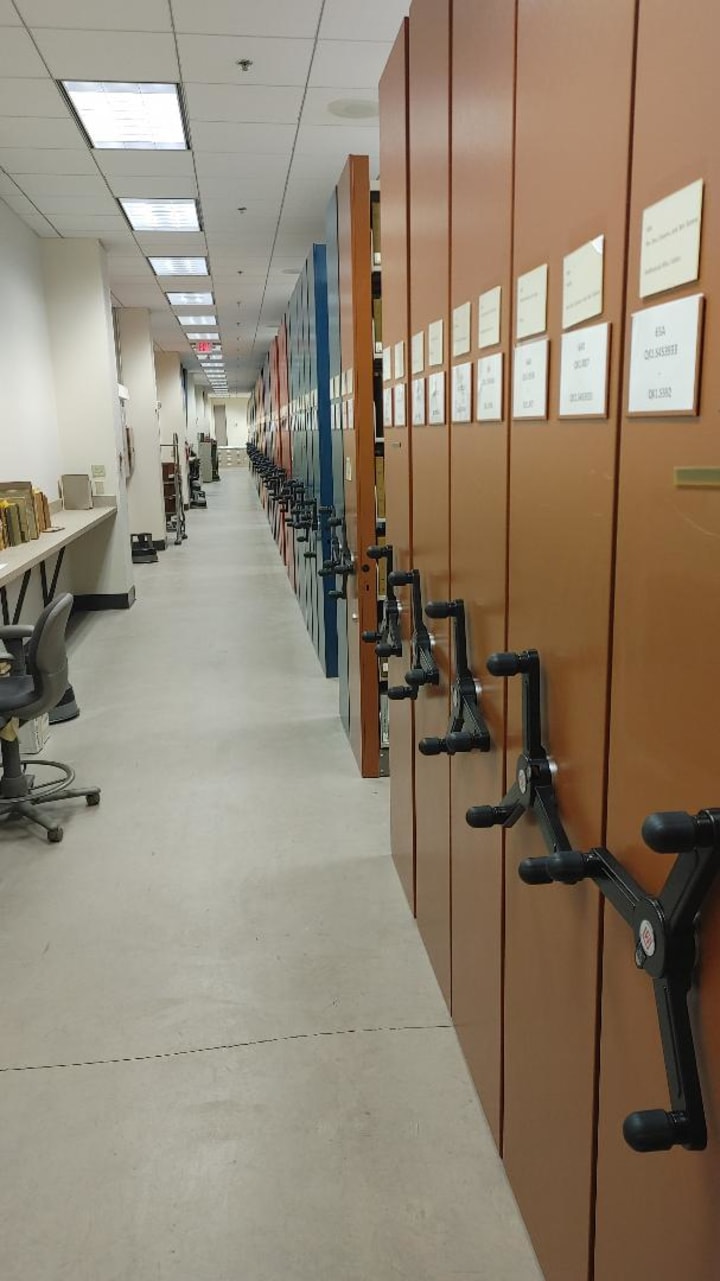
I reached out to some other garden libraries around the world as well. The L. H. Bailey Hortorium Herbarium at Cornell University told me "the collection holdings earlier than 1855 are much less than for the next 50 years, so chances are not great that we will be able to push back that date for you." This tracks with a Cambridge article that talks about how "Between 1850 and 1880, enthusiasm for horticulture swept the nation..." Hence there probably wasn't much of a market for soil prior to 1850.
A caveat: this research only extends to the English speaking world. I started to research French archive at one point, but realized it was pointless for myself to do so.
With that said, it appears likely that selling dirt on a professional level was pioneered by James Salter in 1848 and Jonathan Steele in 1850 in the English speaking world.
About the Creator
Buck Hardcastle
Viscount of Hyrkania and private cartographer to the house of Beifong.






Comments
There are no comments for this story
Be the first to respond and start the conversation.